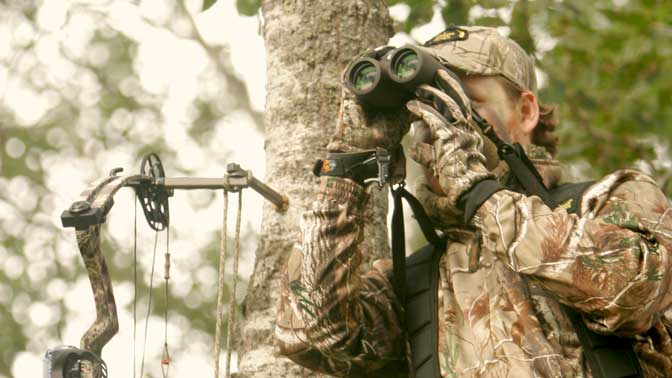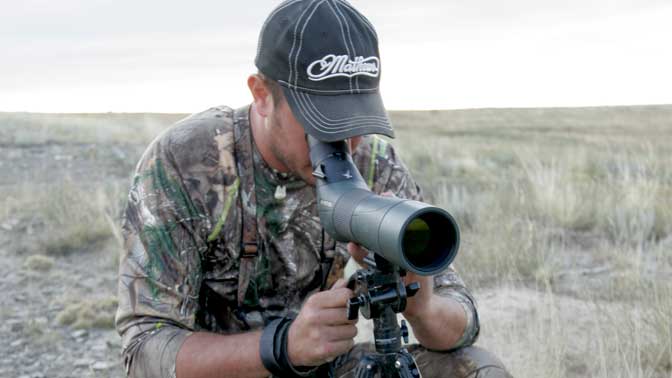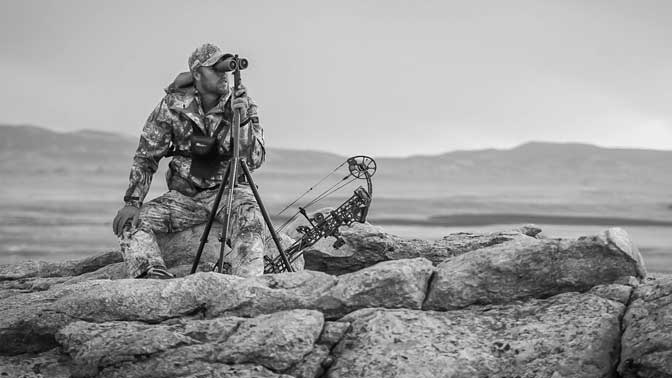Whether you are an Eastern hunter who spends his preseason days scouting from a pickup and hunts mainly from a treestand or a western hunter who spends most of his time hunting on foot, one thing is certain: everyone can increase their odds of success by spending time looking through binoculars and a spotting scope. Here’s how to tip the odds in your favor when it comes to glassing east to west.
Most Western hunters know the value of having a good pair of binoculars and using them regularly, but eastern hunters sometimes struggle with the idea of glassing for hours on end. They also struggle with the idea of spending a lot of money on binoculars. Most whitetails hunters think an inexpensive pair of binoculars is “good enough.”

Glassing from a treestand not only can help you spot a buck it keeps you engaged in the hunt which could help keep you in the stand longer.
Rob Lancellotti from Swarovski believes whitetail hunters are really missing out. “There have been many independent tests done by magazines and editors to determine the differences between high end glass and inexpensive glass. One of the things that stands out to most people is how well high-quality glass performs in lowlight conditions. Look through a pair of high-end binoculars at last light when bucks are on their feet and moving. You will likely still be able to see the deer, his rack and determine where he is going. Often when you try to locate the same buck using inexpensive glass you won’t even be able to see him,” Lancellotti said.
Being able to see a buck in low light conditions is important when hunting and scouting. “Having a pair of binoculars that you can see a buck at last light can really increase a hunters’ odds of success and keeps them focused on hunting and not leaving early,” Lancellotti added. This brings up a great point: let’s face it; at one time or another, all of us have struggled with boredom while deer hunting for long hours. If you are using good glass and seeing deer, you might stay in the stand longer. Looking through a pair of inexpensive binoculars often gives a person a headache. Buying better glass decreases the odds of getting a headache.

Using a tripod such as this Outdoorsmans tripod can help eliminate the shake, which makes glassing easier on the eyes.
Ben Royce from Illinois uses binoculars and a spotting scope to locate big bucks in the preseason and while bowhunting. “I have found and patterned many bucks over the years by sitting on the edge of a field and glassing for hours. Many people don’t have the patience for it but it can help you connect the dots on a big buck,” Royce explained.
If you are glassing on the edge of a field or from a pickup, Cody Nelson from the Outdoorsman’s in Phoenix, Arizona, suggests using a tripod or a window mount. “If one hunter is sitting in a pickup and is glassing freehand looking for bucks and another hunter has his binoculars or tripod mounted on a window mount, the guy using the mounted optics is going to see more game,” says Nelson. The same thing goes for the guy using a tripod in the field. Optics that are solid and steady are much easier to use. Spotting movement is so much easier when the optics are secure and not wiggling around. “When holding a pair of binoculars in my hand, I shake and making out a buck on the other side of a field can be difficult. That is not the case when the same binoculars are steady as a rock in a tripod,” Royce added.
When hunting from a treestand, having a binocular harness and smaller optics is an advantage. “If a person has to dig for their binoculars that are at the bottom of a backpack, they won’t use them much. If their binoculars are too big for the application, they won’t use them much. Hunters should have a harness and buy optics that are designed for their style of hunting and use them constantly when they are deer hunting,” Nelson explained.
The same can be said for Western hunter. “Taking your time and setting up in a location, getting comfortable and spending an hour or more glassing a mountainside when looking for deer or elk will likely help a person fill more tags than stopping every few minutes and glassing a second and taking off again. Patience is the key to success whether a person is glassing for whitetails or elk,” Nelson said. When glassing large fields or a mountainside, Nelson suggests using a grid system. You imagine a grid is in front of you and the field or mountainside is busted up into small squares forming a grid. You move the optics from left to right, across the grid in the upper cube until the horizontal line crosses a vertical. Then come down and move across the next cube. You go left to right and down until you have scanned an entire area. When glassing across each cube, you are looking for movement. If your optics are secured to a tripod, your odds of spotting movement are much greater.
Glassing out west can be a very daunting task so many backcountry hunters don’t bring optics with them because they don’t think they will use them anyway. Nelson says that is a mistake. “Hunters need to realize they can scan a mountain much quicker with optics than they can on foot. High end optics are necessary when glassing out west because they are crystal clear and work well in lowlight conditions when animals move most. Just remember to be patient, get comfortable and glass for long periods. In some cases, I will glass for hours but more often than not, it pays off.” How do you eat an elephant? One bite at a time. How do you find a mule deer on the side of a mountain? Glassing little by little until you spot him.

Using a tripod when glassing with binoculars is also beneficial. Most hunters think of a tripod as a something that is only used when glassing with a spotting scope. When glassing for long periods a tripod also works great at keeping binoculars steady.
Glassing can be fun and rewarding if you do it right. Most of us only pick up our binoculars or a spotting scope when we already see a buck or bull. Instead, use your optics to locate animals you didn’t even know were there. Glassing often can help you spot and pattern animals. Get a good pair of binoculars, a spotting scope, a tripod or a window mount. After you learn how to glass properly, you will look at optics as a long term investment that you will never leave home without.

 By
By 



